Many homeowners face frustration from soap scum, mold and mildew that quickly build up in their fiberglass showers. Despite regular weekly cleaning, these surfaces can still look dull and stained over time.
Fiberglass showers use reinforced fiberglass typically made of woven glass fibers mixed with polyester resin; while durable, harsh cleaners or abrasives will easily damage the smooth gel coat finish.
Instead, homeowners can safely clean fiberglass shower surfaces using common household cleaning products such as baking soda, white vinegar or hydrogen peroxide.
This blog will show simple methods anyone can follow to effectively Clean Fiberglass Shower stalls without damaging them. Keep reading for easy tips and tricks that really work on this deep cleaning.
Key Takeaways
- Clean fiberglass showers gently using baking soda, white vinegar or hydrogen peroxide instead of harsh chemicals to prevent scratches and damage.
- Mix baking soda with distilled white vinegar; let sit 10-15 minutes, then scrub carefully with a non-abrasive sponge to remove dirt and soap scum without harm.
- Use hydrogen peroxide combined with baking soda paste for tougher mold, mildew, or set-in stains; leave on surfaces about 15-20 minutes before gentle scrubbing and rinsing thoroughly.
- Always dry cleaned shower areas fully after each cleaning session to stop mold growth caused by leftover moisture buildup.
- Regular weekly cleaning help fiberglass showers stay bright longer while preventing harder-to-remove grime from forming over time.
Cleaning Supplies You Will Need
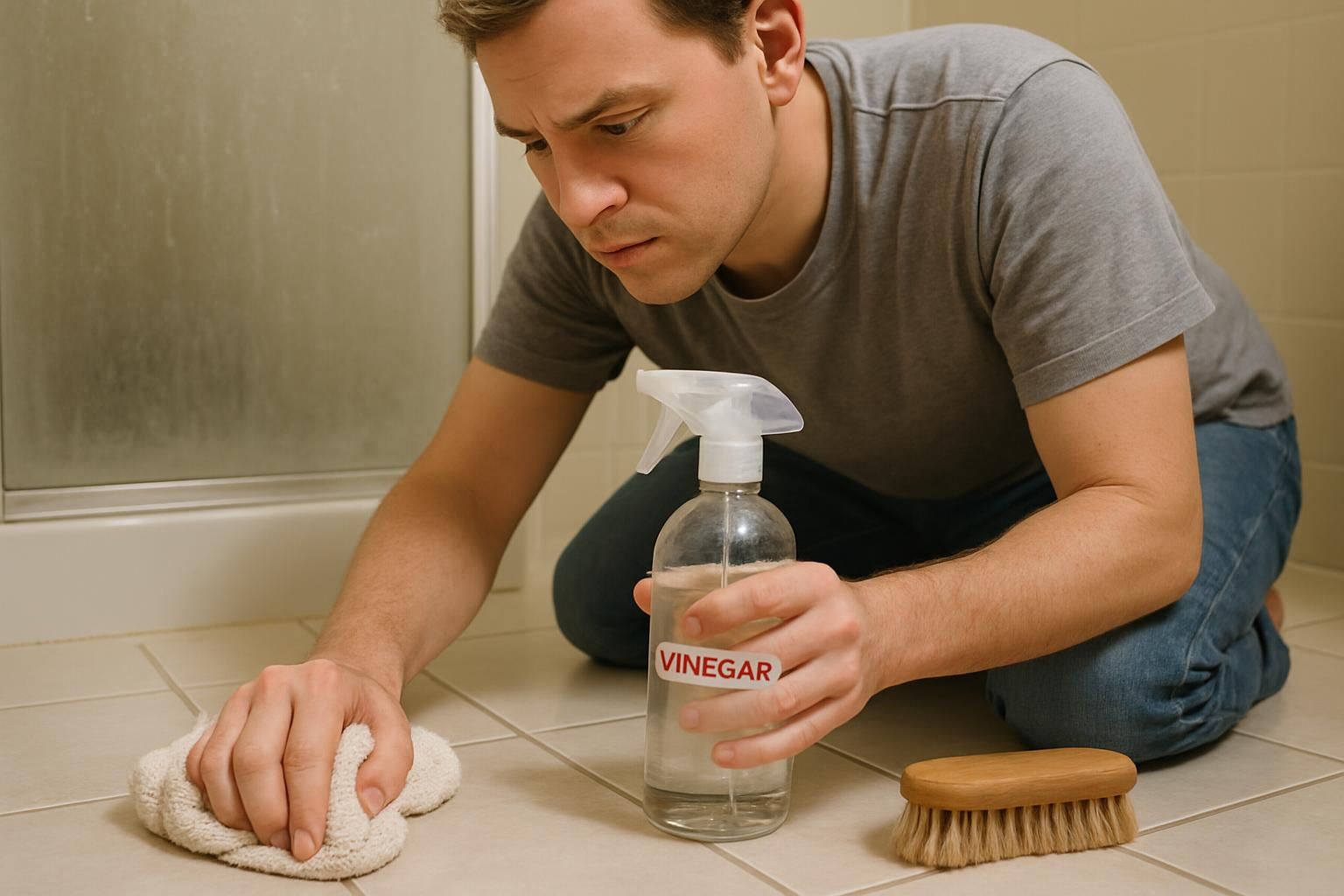
Picking the right cleaning agents makes scrubbing your fiberglass shower a breeze. With simple household helpers, you can kick harsh cleaners to the curb and safely tackle soap scum.
Baking soda
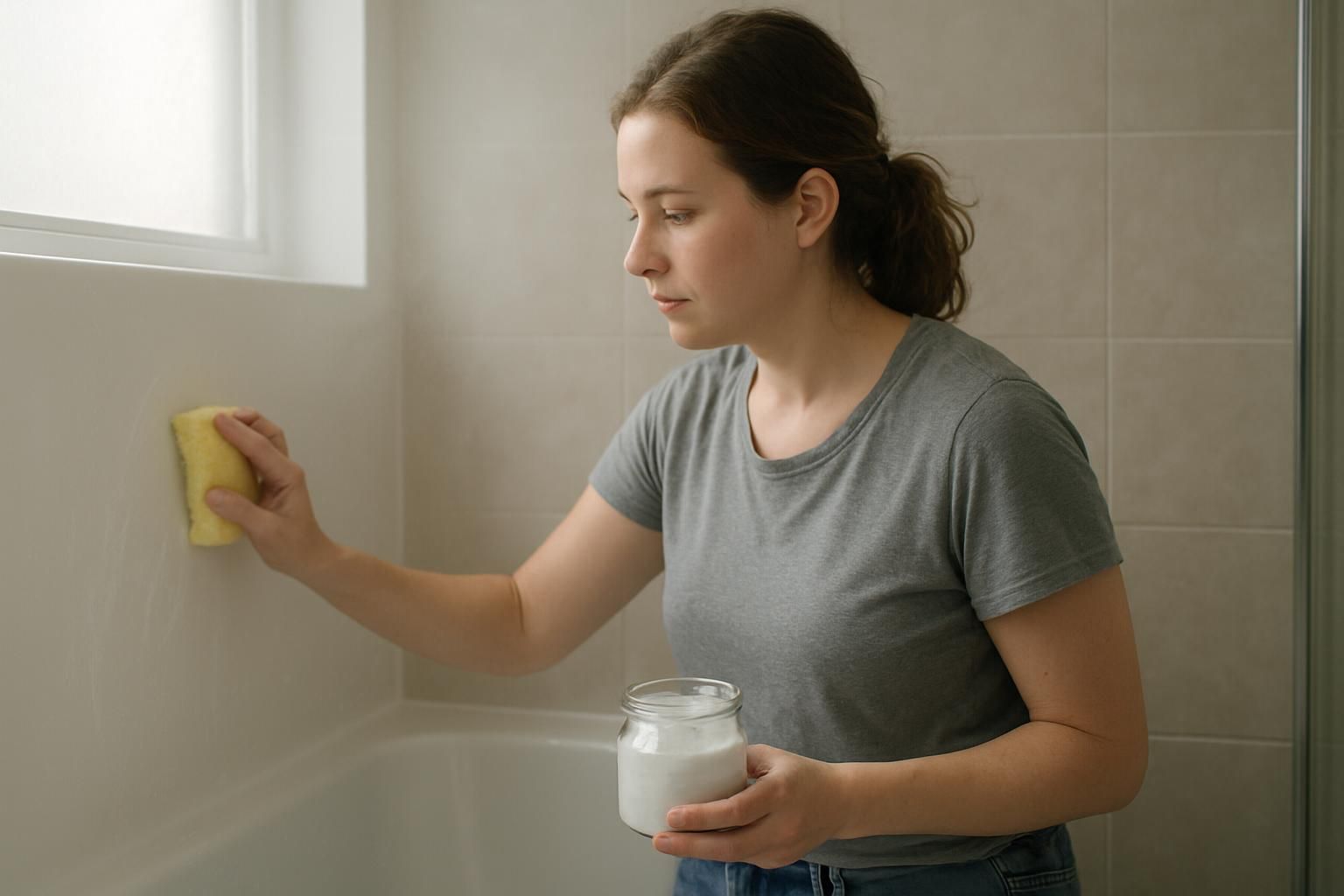
Baking soda handles soap scum and grime like a champ in cleaning fiberglass showers. This mild exfoliant lifts dirt gently without the harsh abrasives found in some cleaning agents.
Families appreciate baking soda due to its safety around kids, with no harmful fumes of harsh cleaners lingering afterward.
Homeowners can sprinkle baking soda directly onto wet surfaces or combine it into pastes for tough shower cleaning. Its natural texture tackles stubborn mold and mildew stains efficiently, leaving composite shower floors spotless.
As an added bonus, baking soda also helps absorb foul odors trapped within damp spaces inside the bathroom area.
Next up is distilled white vinegar a powerful partner ready to step in alongside baking soda and create impressive results together!
Distilled white vinegar
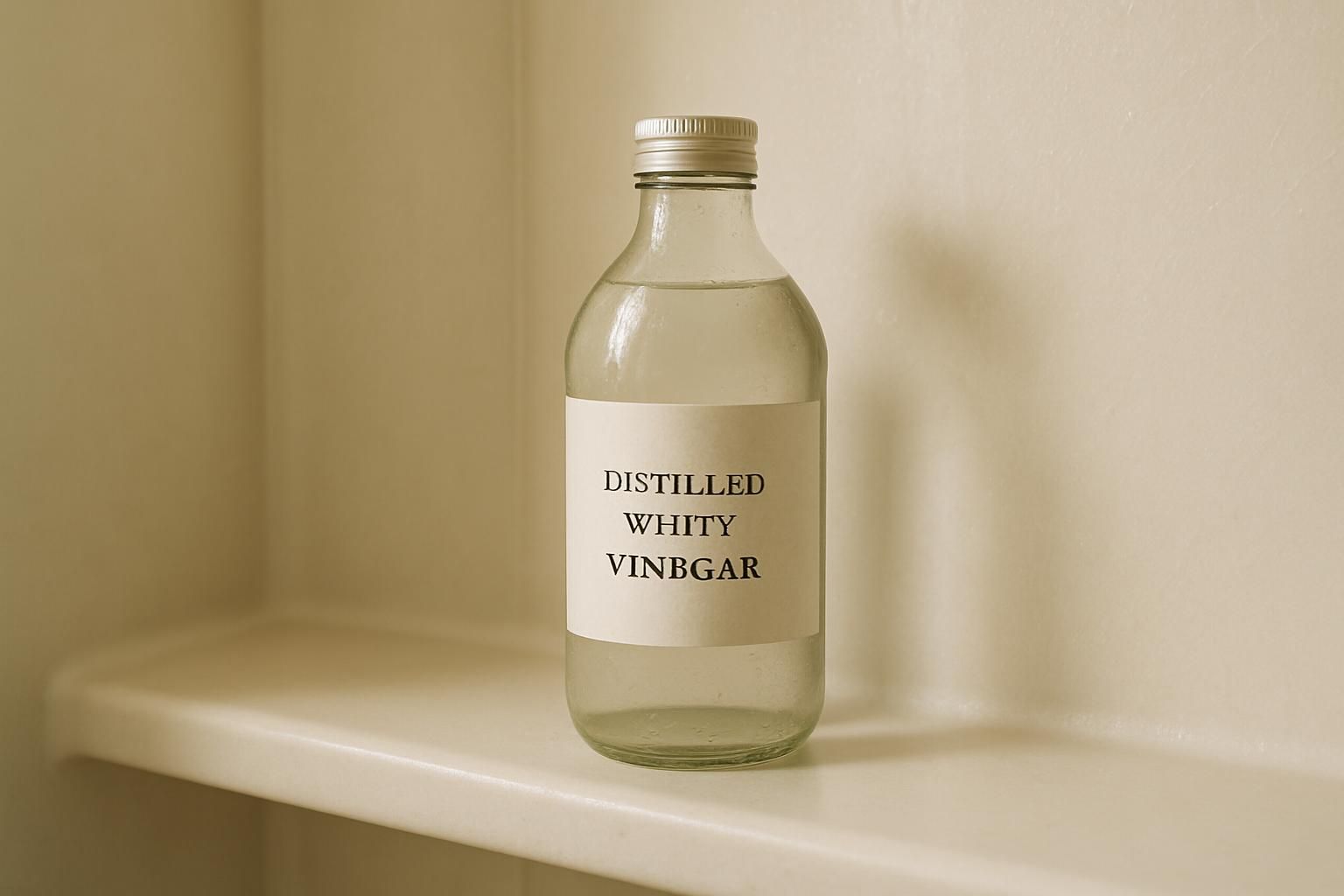
Distilled white vinegar makes cleaning fiberglass showers simple and safe. Its mild acidity breaks down soap scum, mold, mildew, and even hard water spots without harsh cleaners or chemicals.
Homeowners can pour plain white vinegar into a spray bottle to spritz over the shower surfaces weekly; after 10 to 15 minutes, they scrub with a non-abrasive sponge or cloth before rinsing thoroughly.
Vinegar also helps maintain shower curtains clear of soap buildup and prevents mold growth that thrives in damp bathroom environments.
Hydrogen peroxide

Hydrogen peroxide is a strong but gentle way to clean fiberglass showers without harsh cleaners. It fights mold and mildew effectively while being safe on surfaces. Mixing hydrogen peroxide with baking soda makes an effective paste for removing tough stains and soap scum buildup that regular weekly cleaning won’t always solve.
Homeowners can easily apply this simple homemade solution, scrub gently with a non-abrasive sponge, then rinse well for spotless results. Getting rid of set-in dirt or discoloration becomes much easier with hydrogen peroxide at hand.
The following steps explain exactly how to use these household products effectively in shower cleaning routines.
Non-abrasive sponge or cloth
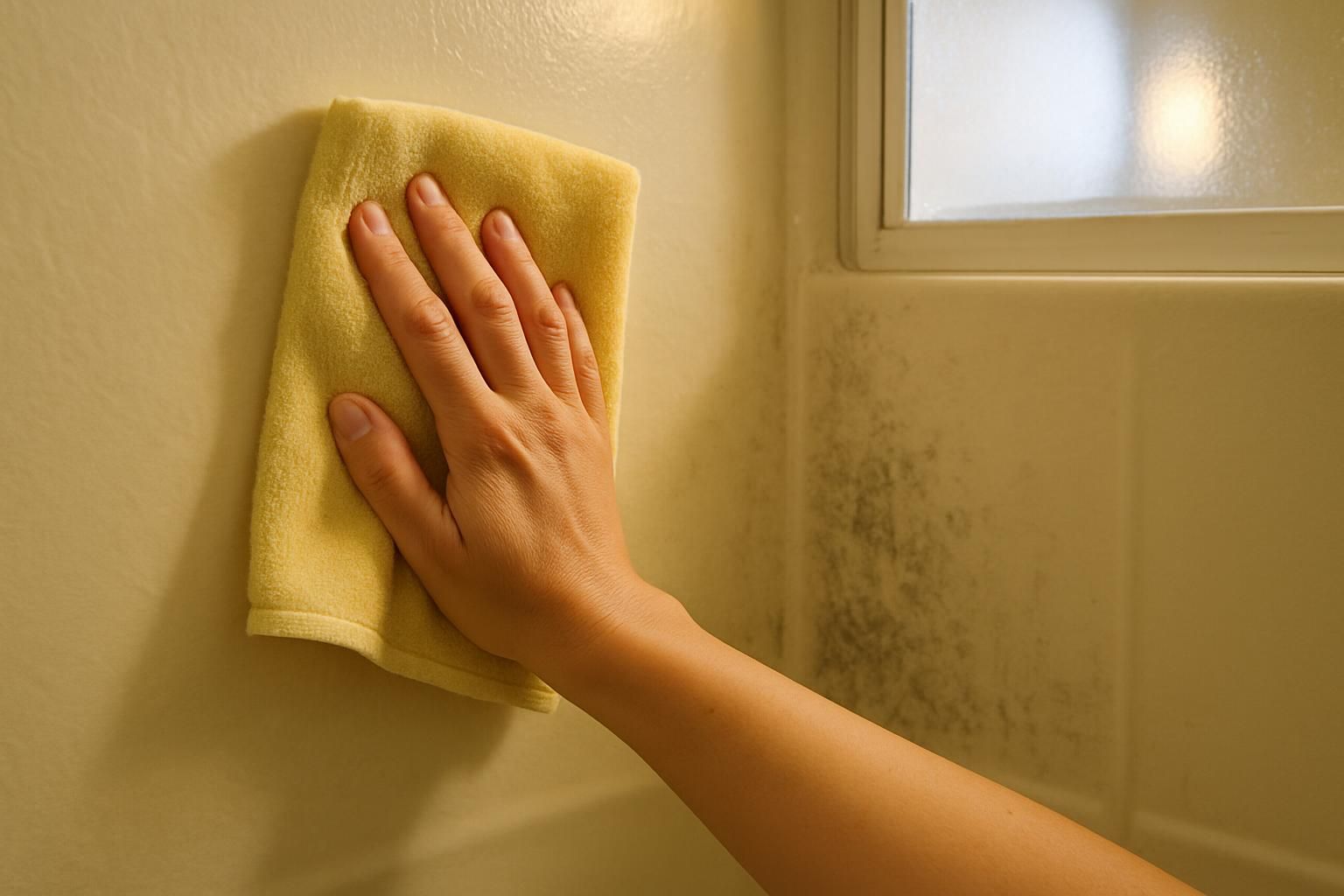
A non-abrasive sponge or soft cloth works well for cleaning fiberglass showers without scratching the surface. Homeowners often deal with soap scum, mold and mildew buildup; using a gentle tool prevents damage that harsher sponges might cause.
Unlike rough scrubbers or steel wool, these soft items are safe enough to use weekly when applying an all-purpose cleaner or solutions made from baking soda, white vinegar, and hydrogen peroxide.
Choosing microfiber cloths can make the job even easier. They trap dirt tightly within tiny fibers and exfoliate shower walls effectively but gently. Rinsing out the sponge frequently during shower cleaning helps prevent spreading germs or grime back onto clean surfaces.
Step-by-Step Cleaning Methods
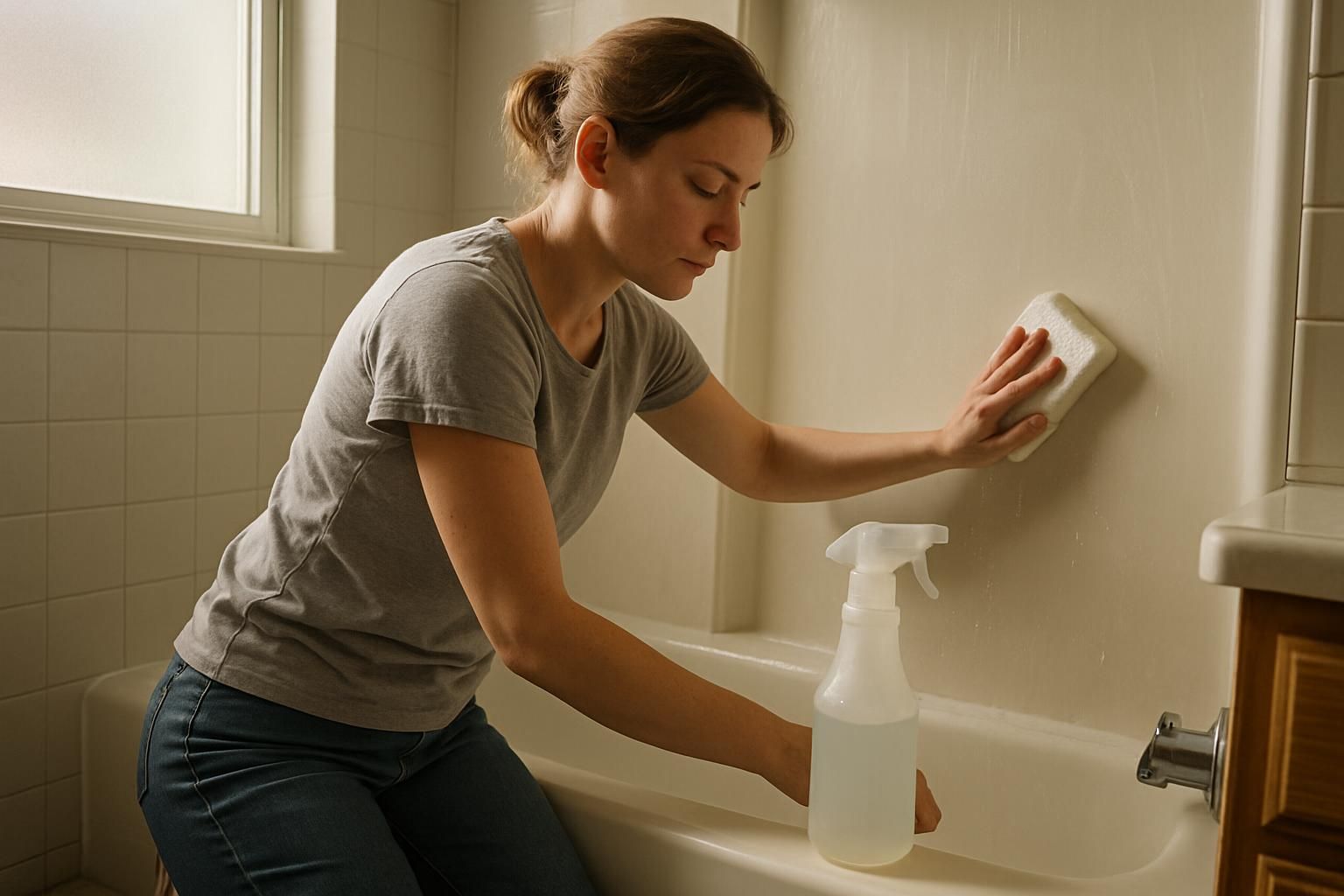
Cleaning a fiberglass shower is simple and quick if homeowners follow these easy methods the results will spark interest in learning more.
How to clean with baking soda and vinegar
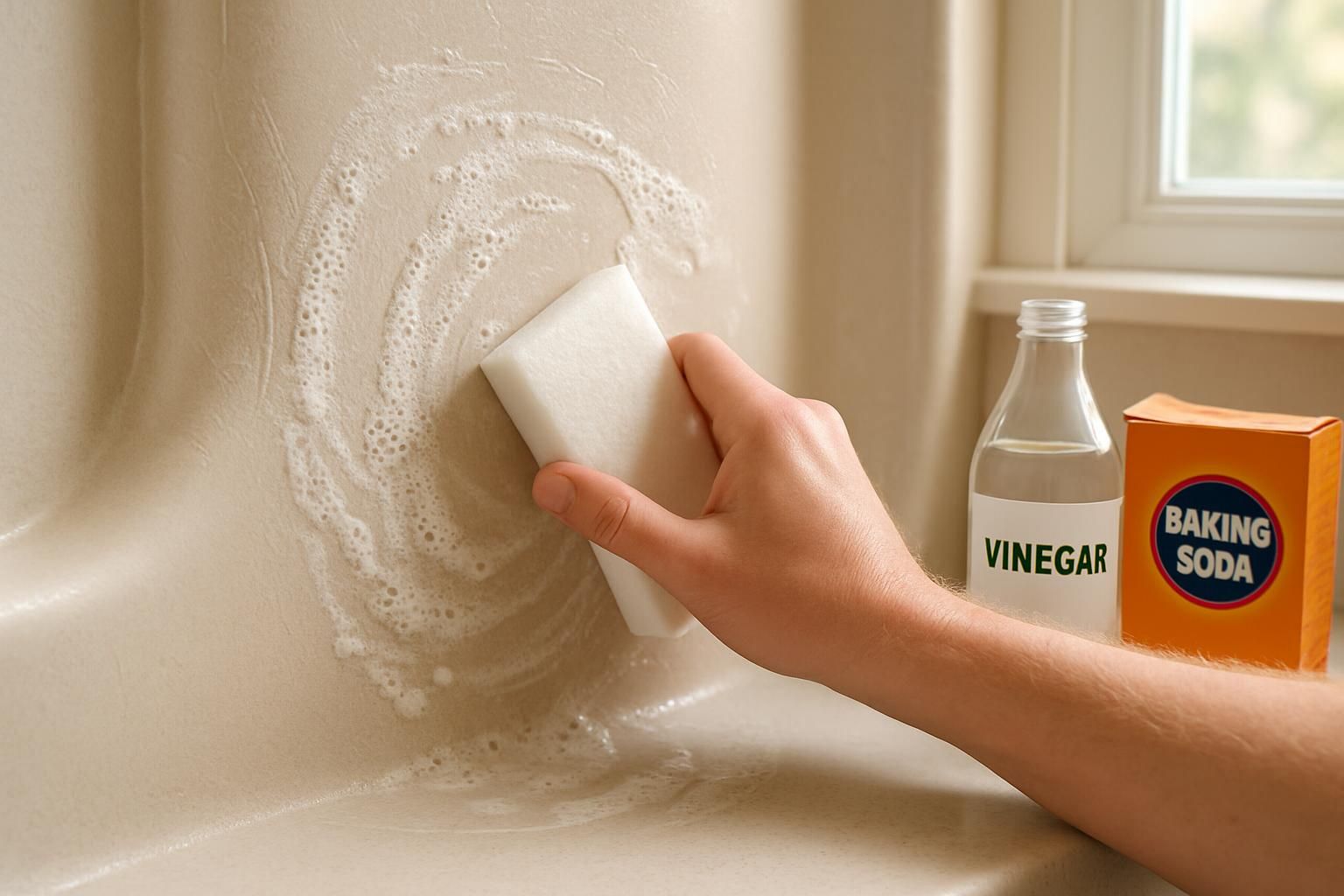
Cleaning fiberglass showers often means battling stubborn soap scum, mold and mildew. Weekly cleaning with baking soda and distilled white vinegar provides an easy yet effective solution for homeowners to keep shower surfaces shiny and spotless.
- Sprinkle baking soda generously across the fiberglass shower floor, walls, corners, and areas with noticeable grime or soap scum stains.
- Fill a spray bottle with half distilled white vinegar mixed evenly with warm water; gently swirl it before spraying to blend fully.
- Spray the vinegar-water mixture thoroughly onto the baking soda already scattered on surfaces; fizzing bubbles will appear as these two substances react together to break down dirt and soap scum quickly.
- Set a timer allow about 10 to 15 minutes for this safe yet powerful mixture to loosen stubborn dirt without harsh cleaners harming fiberglass surfaces.
- After waiting, scrub gently but firmly using a damp non-abrasive sponge or cloth in small circles until all residues lift without scratching or damaging your fiberglass shower finish.
- Rinse carefully using warm water; direct the shower head’s flow over all cleaned areas, ensuring removal of leftover mix completely.
- Wipe dry immediately with a clean towel or microfiber cloth; drying prevents mold growth from lingering moisture and leaves the shower sparkling clean again.
- Allow fresh air circulation through bathroom windows or fans afterward so remaining humidity evaporates easily between weekly cleanings of the fiberglass shower enclosure.
How to clean with hydrogen peroxide and baking soda

While vinegar and baking soda work well for general fiberglass shower cleaning, hydrogen peroxide and baking soda team up perfectly against tough mold and mildew. This combo gently tackles stains without harsh cleaners harming the fiberglass surface.
- Sprinkle a thin layer of baking soda on the stained area of the fiberglass shower to form an even base.
- Pour hydrogen peroxide slowly over the baking soda until it forms a gentle fizzing action; this fizzing breaks through dirt and soap scum.
- Allow this bubbly mixture to sit untouched for 15-20 minutes for better stain breakdown.
- Scrub softly with a non-abrasive sponge or cloth in circular motions; harsh scrubbers can scratch delicate fiberglass surfaces.
- After scrubbing, rinse thoroughly with warm water, making sure no residue remains behind to cause future issues.
- Dry completely using a clean towel or cloth after rinsing to stop new mold or mildew from forming inside your fiberglass shower stall.
- Ventilate the bathroom by opening windows or running exhaust fans regularly after each weekly cleaning session; proper airflow prevents moisture buildup.
- Store leftover supplies like hydrogen peroxide bottles safely away from children’s reach in clearly labeled cabinets to avoid accidents at home.
Safety Precautions
It is important that homeowners wear protective gloves and ensure proper ventilation while cleaning fiberglass showers. Open windows or run exhaust fans during and after the cleaning process. Avoid mixing cleaning agents in a confined space and keep all cleaning products securely stored after use. Review product labels for any specific safety instructions.
If the cleaning results are unsatisfactory, check the water temperature or adjust the ratios of the cleaning agents to better tackle persistent soap scum or discoloration.
Tips for Removing Tough Stains

Kicking stubborn soap scum and mold to the curb can be a breeze check out these easy tips to make your fiberglass shower shine again!
Using a baking soda paste
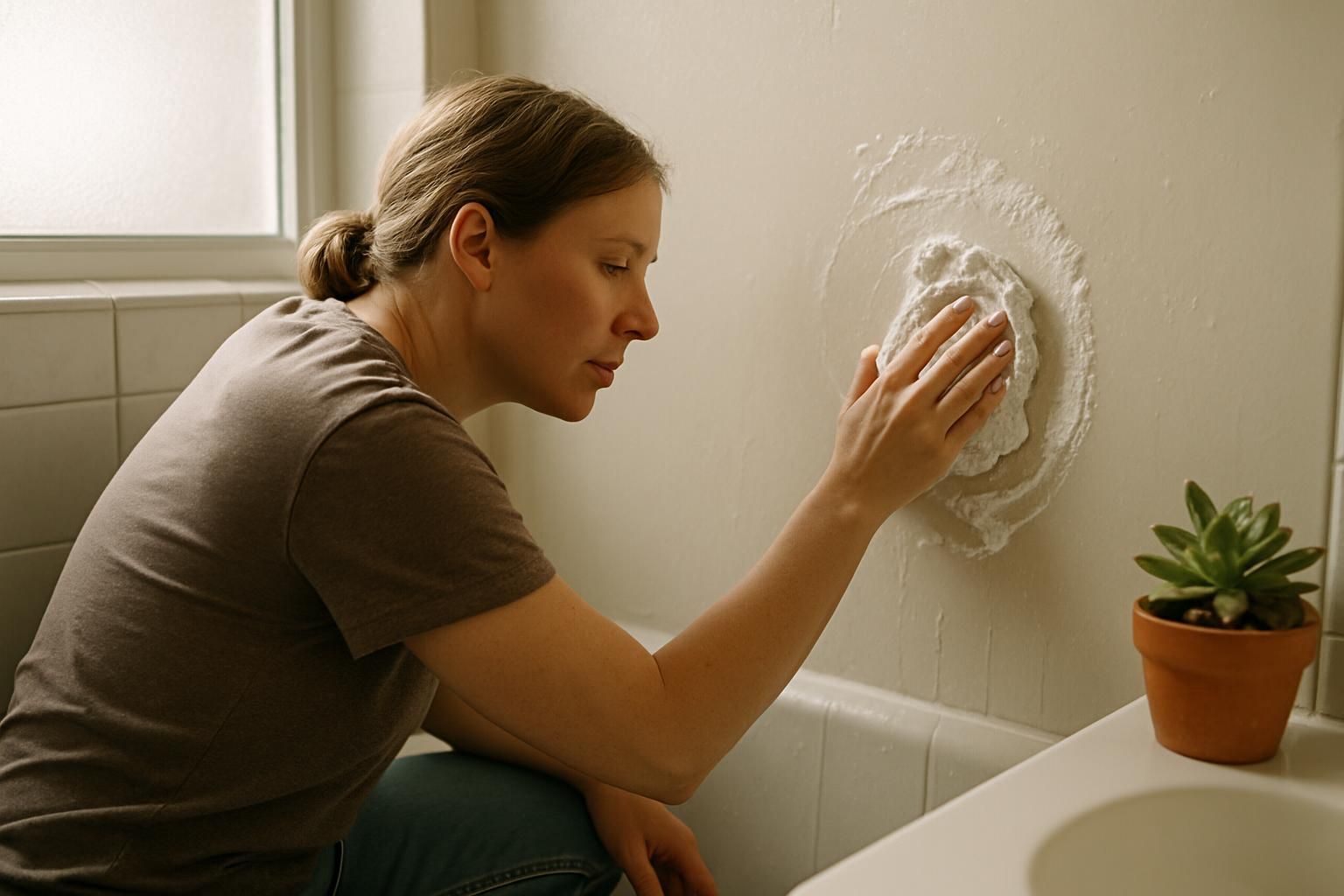
A baking soda paste is a great ally against tough soap scum and stains on fiberglass showers. For best results, mix about half a cup of baking soda with enough water to create a thick paste similar to toothpaste.
Spread this mixture over stained areas using a soft cloth or non-abrasive sponge, then let it sit for 10 to 15 minutes. Next, scrub gently but firmly in circular motions before rinsing off the residue thoroughly; regular weekly cleaning like this helps avoid build-up of mold and mildew without harsh cleaners.
This practical trick easily tackles stubborn grime that vacuum forming surfaces on fiberglass showers often trap. Baking soda acts as an effective yet gentle cleanser because it won’t scratch delicate finishes when applied correctly.
Plus, homeowners can confidently use it around kids since it’s safe, natural and free from harmful chemical fumes.
Applying hydrogen peroxide for set-in stains
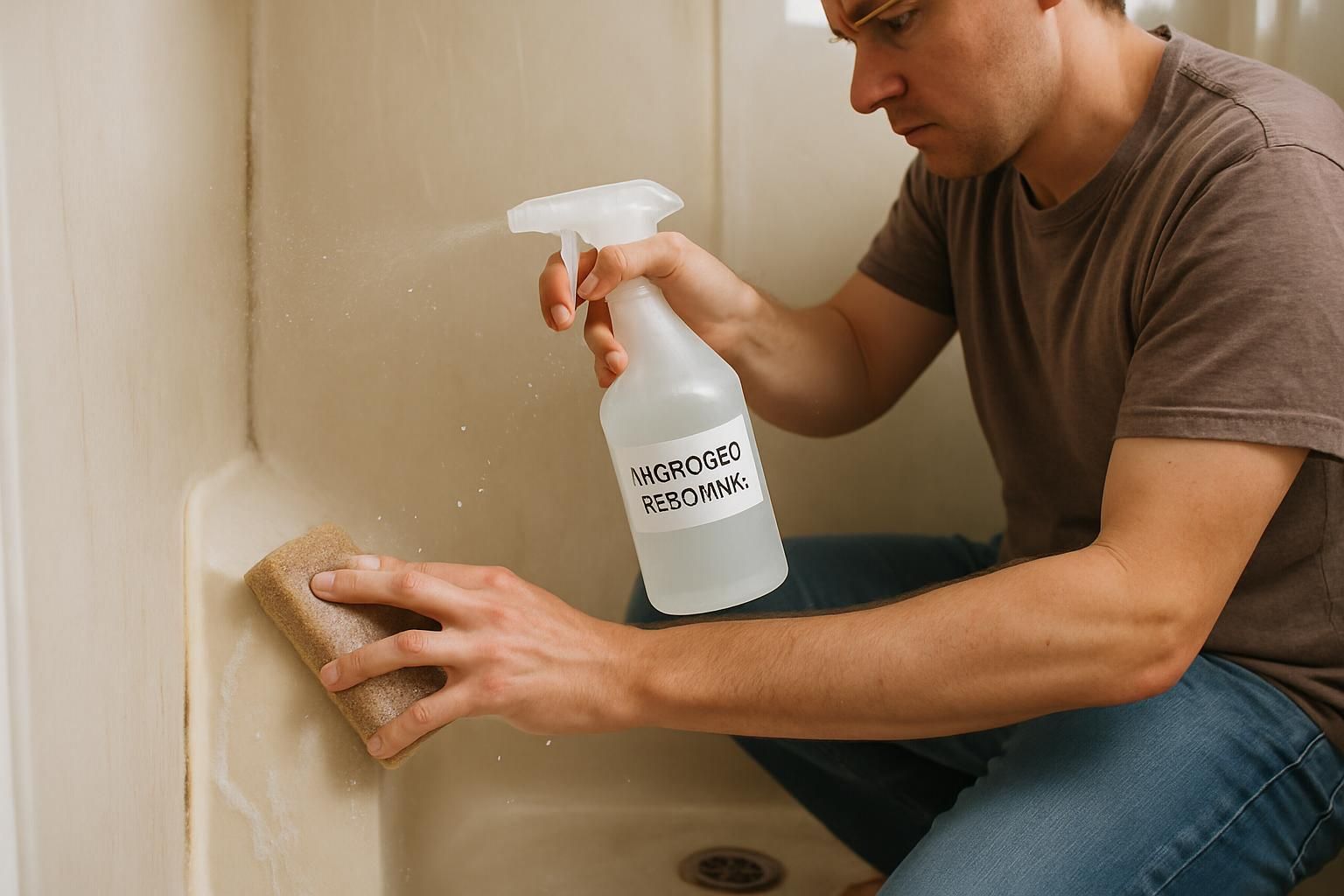
Hydrogen peroxide works wonders on stubborn set-in stains like mold and mildew lurking in fiberglass showers. Homeowners battling hard-to-clean soap scum can pour hydrogen peroxide directly onto the stained areas or spray generously with a bottle, letting it sit for about 15 minutes to bubble away grime.
Next, scrub gently yet firmly with a non-abrasive sponge or cloth until the tough marks lift off cleanly. For extra cleaning power on very persistent discoloration, sprinkling baking soda over the peroxide-covered stain creates a fizzing action that quickly lifts even deeply embedded debris no harsh cleaners needed here!
Conclusion
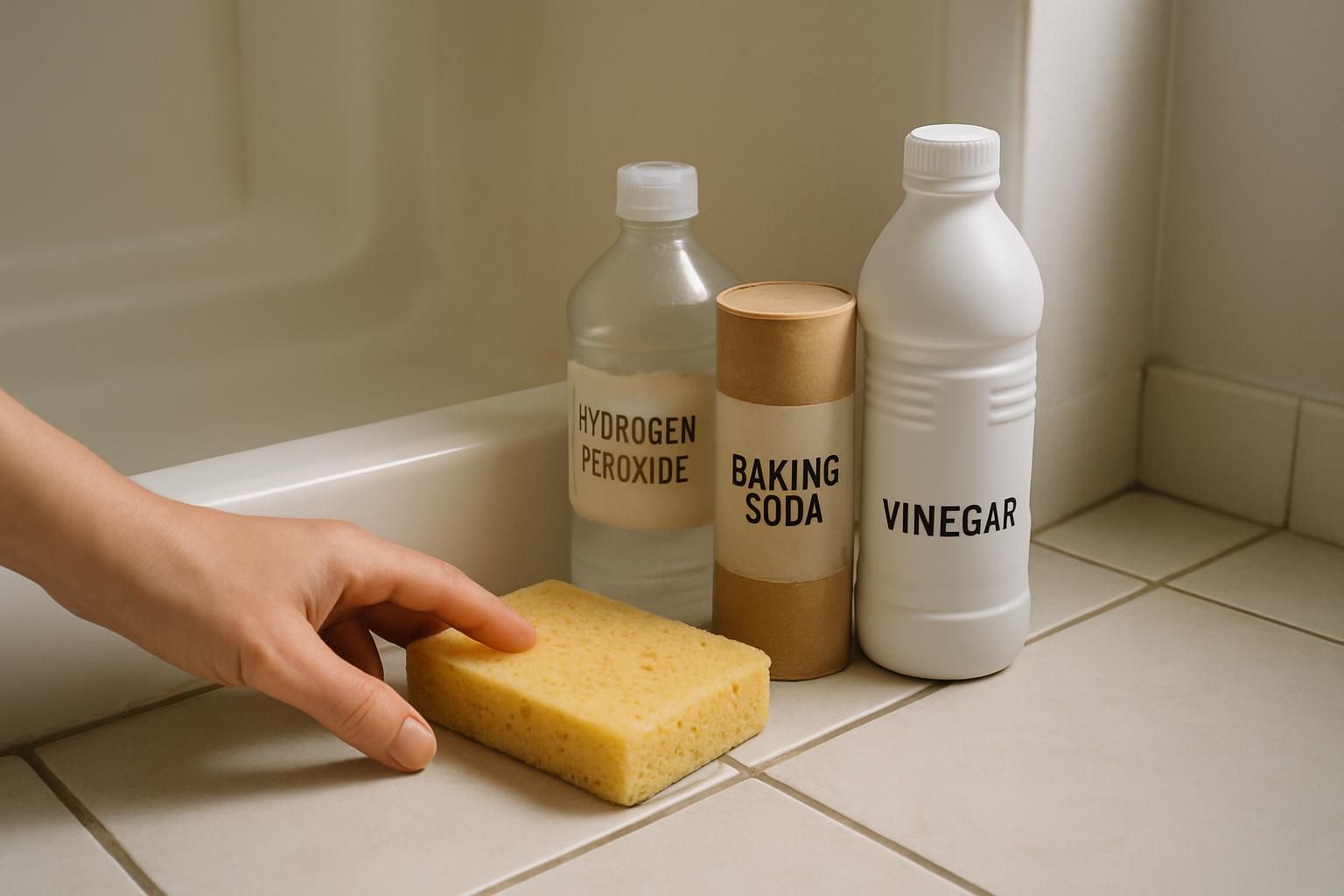
A sparkling fiberglass shower doesn’t require harsh cleaners or fancy tricks. Baking soda, white vinegar, and a gentle sponge can beat soap scum without fuss. For mold and mildew, hydrogen peroxide handles even stubborn patches quickly.
A quick weekly cleaning helps avoid tougher messes down the road. Fiberglass showers stay fresh with just easy habits and simple ingredients found around the house.
FAQs
1. What is the best way to remove soap scum from a fiberglass shower?
Soap scum can be stubborn, but baking soda and white vinegar do wonders. Sprinkle baking soda on the surface, spray with white vinegar, then scrub gently after it bubbles up. Rinse well for a sparkling clean finish.
2. Can hydrogen peroxide safely whiten my fiberglass shower?
Yes, hydrogen peroxide brightens your fiberglass without harsh cleaners or damage. Spray it directly onto stained areas; let sit about 10 minutes before wiping away grime easily.
3. How often should I perform weekly cleaning of my fiberglass shower?
Weekly cleaning keeps soap scum at bay and prevents buildup in your fiberglass shower. A quick wipe-down each week saves you from tougher scrubbing later future-you will thank present-you!
4. Is cleaning fiberglass showers with natural products effective enough?
Absolutely! Natural cleaners like baking soda and white vinegar pack plenty of punch against dirt and stains on your fiberglass surfaces. Plus they’re gentle on both your hands and wallet a win-win situation all around!


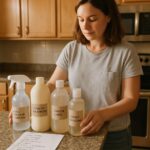

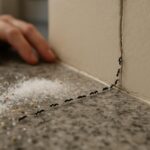


Recent Comments